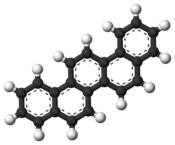Picène
| Picène | |
  Structure du picène |
|
| Identification | |
|---|---|
| Nom UICPA | picène |
| Synonymes |
dibenzo[a,i]phénanthrène |
| No CAS | |
| No ECHA | 100.005.381 |
| No CE | 205-918-7 |
| PubChem | 9162 |
| SMILES | |
| InChI | |
| Propriétés chimiques | |
| Formule | C22H14 [Isomères] |
| Masse molaire[1] | 278,346 6 ± 0,018 6 g/mol C 94,93 %, H 5,07 %, |
| Propriétés physiques | |
| T° fusion | 365,85 °C [2] |
| T° ébullition | 519 °C [3] |
| Solubilité | 0,004 31 mg·l-1 (20 °C,eau) [3] |
| Précautions | |
| Classification du CIRC | |
| Groupe 3 : Inclassable quant à sa cancérogénicité pour l'Homme[4] | |
| Écotoxicologie | |
| LogP | 7,11 [3] |
| Unités du SI et CNTP, sauf indication contraire. | |
| modifier |
|
Le picène est un hydrocarbure aromatique polycyclique obtenu par distillation du goudron et du pétrole, jusqu'à cristallisation par distillations répétées conduisant au produit sec. Il peut être préparé de façon synthétique en faisant réagir du chlorure d'aluminium AlCl3 anhydre sur du naphtalène et du 1,2-dibromoéthane BrH2C–CH2Br. Il cristallise en grandes plaques incolores qui présentent une fluorescence bleue aux ultraviolets.
Le picène est soluble dans l'acide sulfurique H2SO4 en donnant une solution verte. L'acide chromique H2CrO4 dans l'acide acétique H3C–COOH oxyde le picène en acide phtalique, en passant par un stade picène-quinone.
En 2010, des chercheurs ont annoncé avoir observé que le picène auquel on ajoute des atomes de potassium dans certaines proportions devient supraconducteur[5],[6].
Notes et références
[modifier | modifier le code]- Masse molaire calculée d’après « Atomic weights of the elements 2007 », sur www.chem.qmul.ac.uk.
- (en) « Picene », sur NIST/WebBook, consulté le 25 juin 2009
- (en) « Picène », sur ChemIDplus, consulté le 25 juin 2009
- IARC Working Group on the Evaluation of Carcinogenic Risks to Humans, « Evaluations Globales de la Cancérogénicité pour l'Homme, Groupe 3 : Inclassables quant à leur cancérogénicité pour l'Homme »(Archive.org • Wikiwix • Archive.is • Google • Que faire ?), sur monographs.iarc.fr, CIRC, (consulté le ).
- (en) Ryoji Mitsuhashi, « Superconductivity in alkali-metal-doped picene », Nature, vol. 464, nos 76-79, (ISSN 1476-4687, lire en ligne)
- Un hydrocarbure insaturé devient supraconducteur, sur futura-sciences.com.
Articles connexes
[modifier | modifier le code]Text is available under the CC BY-SA 4.0 license; additional terms may apply.
Images, videos and audio are available under their respective licenses.
